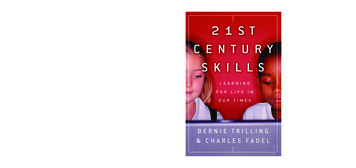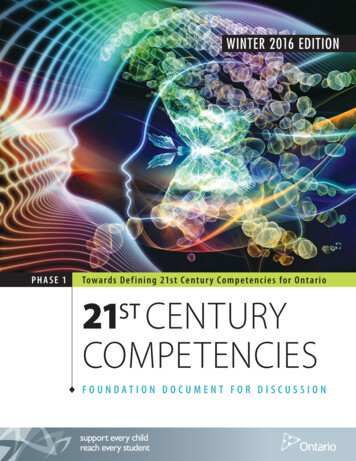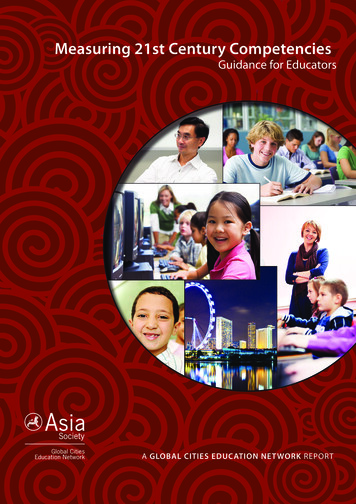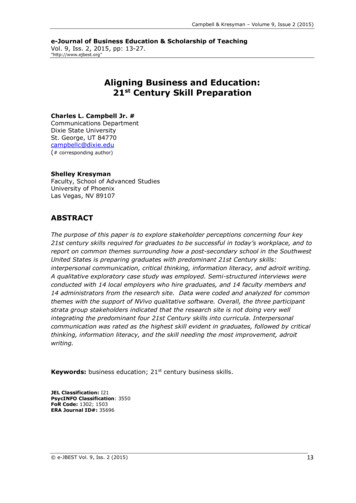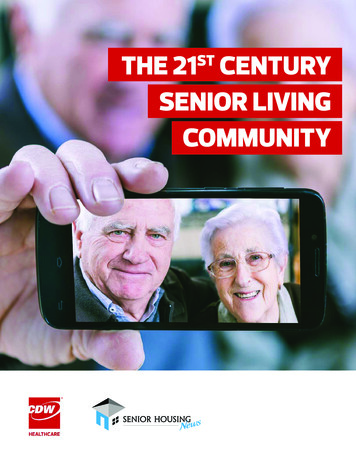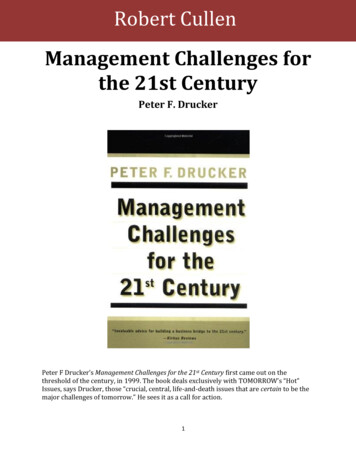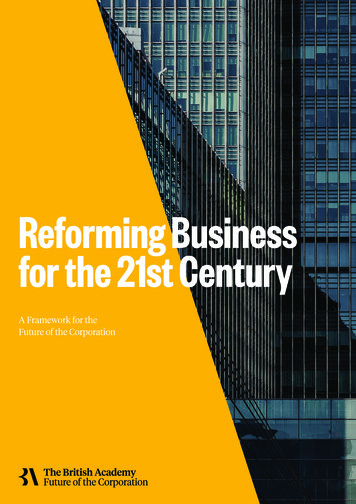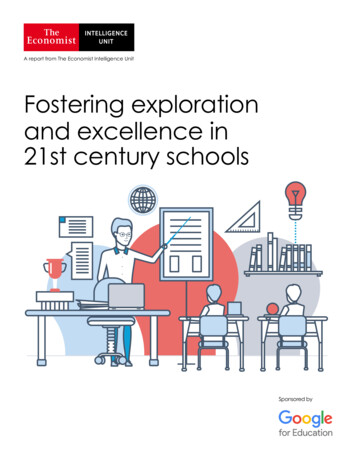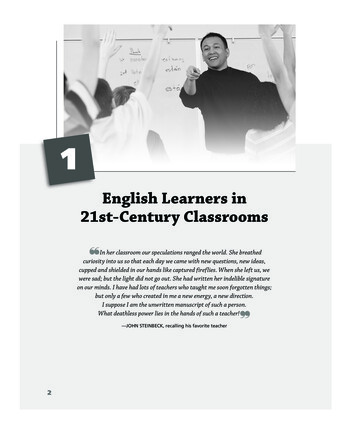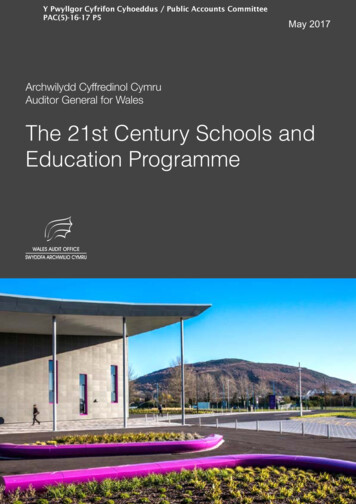
Transcription
Framework for21st Century LearningThe Partnership for 21st Century Skills has developed a vision for student successin the new global economy.21st Century Student Outcomes and Support Systems21ST CENTURY STUDENT OUTCOMESTo help practitioners integrate skills into the teaching of core academic subjects, the Partnership hasdeveloped a unified, collective vision for learning known as the Framework for 21st Century Learning.This Framework describes the skills, knowledge and expertise students must master to succeed inwork and life; it is a blend of content knowledge, specific skills, expertise and literacies.Every 21st century skills implementation requires the development of core academic subjectknowledge and understanding among all students. Those who can think critically and communicateeffectively must build on a base of core academic subject knowledge.Within the context of core knowledge instruction, students must also learn the essential skillsfor success in today’s world, such as critical thinking, problem solving, communicationand collaboration.Publication date: 12/09When a school or district builds on this foundation, combining the entire Framework with thenecessary support systems—standards, assessments, curriculum and instruction, professionaldevelopment and learning environments—students are more engaged in the learning process andgraduate better prepared to thrive in today’s global economy.177 N. Church Avenue, Suite 305Tucson, AZ 85701520-623-2466www.21stcenturyskills.org
Core Subjects and 21st Century ThemesMastery of core subjects and 21st century themes is essential to student success. Core subjectsinclude English, reading or language arts, world languages, arts, mathematics, economics, science, geography,history, government and civics.In addition, schools must promote an understanding of academic content at much higher levels by weaving21st century interdisciplinary themes into core subjects: Global AwarenessFinancial, Economic, Business and Entrepreneurial LiteracyCivic LiteracyHealth LiteracyEnvironmental LiteracyMemberOrganizations Adobe Systems, Inc. American Association ofSchool Librarians Apple ASCD Blackboard, Inc. Cable in the Classroom Crayola Cisco Systems, Inc. Corporation for PublicBroadcastingLearning and Innovation Skills Dell, Inc.Learning and innovation skills are what separate students who are prepared for increasingly complex lifeand work environments in today’s world and those who are not. They include: EF Education Creativity and Innovation Critical Thinking and Problem Solving Communication and Collaboration Educational TestingService Education Networks ofAmerica Gale, Cengage Learning Hewlett PackardInformation, Media and Technology Skills Houghton MifflinHarcourtToday, we live in a technology and media-driven environment, marked by access to an abundanceof information, rapid changes in technology tools and the ability to collaborate and make individualcontributions on an unprecedented scale. Effective citizens and workers must be able to exhibit a range offunctional and critical thinking skills, such as: Intel Corporation Information Literacy Media Literacy ICT (Information, Communications and Technology) Literacy KnowledgeWorksFoundation Lenovo Learning PointAssociatesToday’s life and work environments require far more than thinking skills and content knowledge. The abilityto navigate the complex life and work environments in the globally competitive information age requiresstudents to pay rigorous attention to developing adequate life and career skills, such as:Flexibility and AdaptabilityInitiative and Self-DirectionSocial and Cross-Cultural SkillsProductivity and AccountabilityLeadership and Responsibility Leadership and LearningCenter McGraw-Hill Measured Progress Microsoft Corporation National EducationAssociation National AcademyFoundation Nellie Mae EducationFoundation netTrekker21ST CENTURY SUPPORT SYSTEMS Oracle EducationFoundationDeveloping a comprehensive framework for 21st century learning requires more than identifying specificskills, content knowledge, expertise and literacies. An innovative support system must be created to helpstudents master the multi-dimensional abilities that will be required of them. The Partnership has identifiedfive critical support systems to ensure student mastery of 21st century skills: K12 LEGO GroupLife and Career Skills JA Worldwide 21st Century StandardsAssessments of 21st Century Skills21st Century Curriculum and Instruction21st Century Professional Development21st Century Learning Environments Pearson Project ManagementInstitute EducationalFoundation Quarasan! Scholastic Education Sesame Workshop Sun Microsystems, Inc. The Walt DisneyCompany VerizonFor more information, visit the Partnership’s website at www.21stcenturyskills.org.177 N. Church Avenue, Suite 305Tucson, AZ 85701520-623-2466www.21stcenturyskills.org
P21 Framework DefinitionsTo help practitioners integrate skills into the teaching of core academic subjects, thePartnership has developed a unified, collective vision for learning known as theFramework for 21st Century Learning. This Framework describes the skills, knowledgeand expertise students must master to succeed in work and life; it is a blend of contentknowledge, specific skills, expertise and literacies.Every 21st century skills implementation requires the development of core academicsubject knowledge and understanding among all students. Those who can think criticallyand communicate effectively must build on a base of core academic subject knowledge.Within the context of core knowledge instruction, students must also learn theessential skills for success in today’s world, such as critical thinking, problemsolving, communication and collaboration.When a school or district builds on this foundation, combining the entire Framework withthe necessary support systems—standards, assessments, curriculum and instruction,professional development and learning environments—students are more engaged in thelearning process and graduate better prepared to thrive in today’s global economy.While the graphic represents each element distinctly for descriptive purposes,the Partnership views all the components as fully interconnected in the processof 21st century teaching and learning.P21 Framework DefinitionsPublication date: 12/09Page 1 of 9
21st CENTURY STUDENT OUTCOMESThe elements described in this section as “21st century student outcomes” (representedby the rainbow) are the knowledge, skills and expertise students should master tosucceed in work and life in the 21st century.CORE SUBJECTS AND 21st CENTURY THEMESMastery of core subjects and 21st century themes is essential for all students inthe 21st century. Core subjects include: English, reading or language arts World languages Arts Mathematics Economics Science Geography History Government and CivicsIn addition to these subjects, we believe schools must move to include not only afocus on mastery of core subjects, but also promote understanding of academiccontent at much higher levels by weaving 21st century interdisciplinary themesinto core subjects:Global Awareness Using 21st century skills to understand and address global issues Learning from and working collaboratively with individuals representingdiverse cultures, religions and lifestyles in a spirit of mutual respect andopen dialogue in personal, work and community contexts Understanding other nations and cultures, including the use of non-EnglishlanguagesFinancial, Economic, Business and Entrepreneurial Literacy Knowing how to make appropriate personal economic choices Understanding the role of the economy in society Using entrepreneurial skills to enhance workplace productivity and careeroptionsCivic Literacy Participating effectively in civic life through knowing how to stay informedand understanding governmental processes Exercising the rights and obligations of citizenship at local, state, nationaland global levels Understanding the local and global implications of civic decisionsP21 Framework DefinitionsPublication date: 12/09Page 2 of 9
Health Literacy Obtaining, interpreting and understanding basic health information andservices and using such information and services in ways that enhancehealth Understanding preventive physical and mental health measures, includingproper diet, nutrition, exercise, risk avoidance and stress reduction Using available information to make appropriate health-related decisions Establishing and monitoring personal and family health goals Understanding national and international public health and safety issuesEnvironmental Literacy Demonstrate knowledge and understanding of the environment and thecircumstances and conditions affecting it, particularly as relates to air,climate, land, food, energy, water and ecosystems Demonstrate knowledge and understanding of society’s impact on thenatural world (e.g., population growth, population development, resourceconsumption rate, etc.) Investigate and analyze environmental issues, and make accurateconclusions about effective solutions Take individual and collective action towards addressing environmentalchallenges (e.g., participating in global actions, designing solutions thatinspire action on environmental issues)LEARNING AND INNOVATION SKILLSLearning and innovation skills increasingly are being recognized as those that separatestudents who are prepared for a more and more complex life and work environments inthe 21st century, and those who are not. A focus on creativity, critical thinking,communication and collaboration is essential to prepare students for the future.CREATIVITY AND INNOVATIONThink Creatively Use a wide range of idea creation techniques (such as brainstorming) Create new and worthwhile ideas (both incremental and radical concepts) Elaborate, refine, analyze and evaluate their own ideas in order to improve andmaximize creative effortsWork Creatively with Others Develop, implement and communicate new ideas to others effectively Be open and responsive to new and diverse perspectives; incorporate groupinput and feedback into the work Demonstrate originality and inventiveness in work and understand the realworld limits to adopting new ideas View failure as an opportunity to learn; understand that creativity andinnovation is a long-term, cyclical process of small successes and frequentmistakesP21 Framework DefinitionsPublication date: 12/09Page 3 of 9
Implement Innovations Act on creative ideas to make a tangible and useful contribution to the field inwhich the innovation will occurCRITICAL THINKING AND PROBLEM SOLVINGReason Effectively Use various types of reasoning (inductive, deductive, etc.) as appropriate tothe situationUse Systems Thinking Analyze how parts of a whole interact with each other to produce overalloutcomes in complex systemsMake Judgments and Decisions Effectively analyze and evaluate evidence, arguments, claims and beliefs Analyze and evaluate major alternative points of view Synthesize and make connections between information and arguments Interpret information and draw conclusions based on the best analysis Reflect critically on learning experiences and processesSolve Problems Solve different kinds of non-familiar problems in both conventional andinnovative ways Identify and ask significant questions that clarify various points of view andlead to better solutionsCOMMUNICATION AND COLLABORATIONCommunicate Clearly Articulate thoughts and ideas effectively using oral, written and nonverbalcommunication skills in a variety of forms and contexts Listen effectively to decipher meaning, including knowledge, values, attitudesand intentions Use communication for a range of purposes (e.g. to inform, instruct, motivateand persuade) Utilize multiple media and technologies, and know how to judge theireffectiveness a priori as well as assess their impact Communicate effectively in diverse environments (including multi-lingual)Collaborate with Others Demonstrate ability to work effectively and respectfully with diverse teams Exercise flexibility and willingness to be helpful in making necessarycompromises to accomplish a common goal Assume shared responsibility for collaborative work, and value the individualcontributions made by each team memberP21 Framework DefinitionsPublication date: 12/09Page 4 of 9
INFORMATION, MEDIA AND TECHNOLOGY SKILLSPeople in the 21st century live in a technology and media-suffused environment, markedby various characteristics, including: 1) access to an abundance of information, 2) rapidchanges in technology tools, and 3) the ability to collaborate and make individualcontributions on an unprecedented scale. To be effective in the 21st century, citizens andworkers must be able to exhibit a range of functional and critical thinking skills related toinformation, media and technology.INFORMATION LITERACYAccess and Evaluate Information Access information efficiently (time) and effectively (sources) Evaluate information critically and competentlyUse and Manage Information Use information accurately and creatively for the issue or problem at hand Manage the flow of information from a wide variety of sources Apply a fundamental understanding of the ethical/legal issues surrounding theaccess and use of informationMEDIA LITERACYAnalyze Media Understand both how and why media messages are constructed, and for whatpurposes Examine how individuals interpret messages differently, how values and pointsof view are included or excluded, and how media can influence beliefs andbehaviors Apply a fundamental understanding of the ethical/legal issues surrounding theaccess and use of mediaCreate Media Products Understand and utilize the most appropriate media creation tools,characteristics and conventions Understand and effectively utilize the most appropriate expressions andinterpretations in diverse, multi-cultural environmentsICT (Information, Communications and Technology) LITERACYApply Technology Effectively Use technology as a tool to research, organize, evaluate and communicateinformation Use digital technologies (computers, PDAs, media players, GPS, etc.),communication/networking tools and social networks appropriately to access,P21 Framework DefinitionsPublication date: 12/09Page 5 of 9
manage, integrate, evaluate and create information to successfully function ina knowledge economyApply a fundamental understanding of the ethical/legal issues surrounding theaccess and use of information technologiesLIFE AND CAREER SKILLSToday’s life and work environments require far more than thinking skills and contentknowledge. The ability to navigate the complex life and work environments in theglobally competitive information age requires students to pay rigorous attention todeveloping adequate life and career skills.FLEXIBILITY AND ADAPTABILITYAdapt to Change Adapt to varied roles, jobs responsibilities, schedules and contexts Work effectively in a climate of ambiguity and changing prioritiesBe Flexible Incorporate feedback effectively Deal positively with praise, setbacks and criticism Understand, negotiate and balance diverse views and beliefs to reach workablesolutions, particularly in multi-cultural environmentsINITIATIVE AND SELF-DIRECTIONManage Goals and Time Set goals with tangible and intangible success criteria Balance tactical (short-term) and strategic (long-term) goals Utilize time and manage workload efficientlyWork Independently Monitor, define, prioritize and complete tasks without direct oversightBe Self-directed Learners Go beyond basic mastery of skills and/or curriculum to explore and expandone’s own learning and opportunities to gain expertise Demonstrate initiative to advance skill levels towards a professional level Demonstrate commitment to learning as a lifelong process Reflect critically on past experiences in order to inform future progressSOCIAL AND CROSS-CULTURAL SKILLSInteract Effectively with Others Know when it is appropriate to listen and when to speak Conduct themselves in a respectable, professional mannerWork Effectively in Diverse TeamsP21 Framework DefinitionsPublication date: 12/09Page 6 of 9
Respect cultural differences and work effectively with people from a range ofsocial and cultural backgroundsRespond open-mindedly to different ideas and valuesLeverage social and cultural differences to create new ideas and increase bothinnovation and quality of workPRODUCTIVITY AND ACCOUNTABILITYManage Projects Set and meet goals, even in the face of obstacles and competing pressures Prioritize, plan and manage work to achieve the intended resultProduce Results Demonstrate additional attributes associated with producing high qualityproducts including the abilities to:- Work positively and ethically- Manage time and projects effectively- Multi-task- Participate actively, as well as be reliable and punctual- Present oneself professionally and with proper etiquette- Collaborate and cooperate effectively with teams- Respect and appreciate team diversity- Be accountable for resultsLEADERSHIP AND RESPONSIBILITYGuide and Lead Others Use interpersonal and problem-solving skills to influence and guide otherstoward a goal Leverage strengths of others to accomplish a common goal Inspire others to reach their very best via example and selflessness Demonstrate integrity and ethical behavior in using influence and powerBe Responsible to Others Act responsibly with the interests of the larger community in mind21st CENTURY SUPPORT SYSTEMSThe elements described below are the critical systems necessary to ensure studentmastery of 21st century skills. 21st century standards, assessments, curriculum,instruction, professional development and learning environments must be aligned toproduce a support system that produces 21st century outcomes for today’s students.21st Century Standards Focus on 21st century skills, content knowledge and expertiseP21 Framework DefinitionsPublication date: 12/09Page 7 of 9
Build understanding across and among core subjects as well as 21st centuryinterdisciplinary themesEmphasize deep understanding rather than shallow knowledgeEngage students with the real world data, tools and experts they will encounterin college, on the job, and in life; students learn best when actively engaged insolving meaningful problemsAllow for multiple measures of masteryAssessment of 21st Century Skills Supports a balance of assessments, including high-quality standardized testingalong with effective formative and summative classroom assessments Emphasizes useful feedback on student performance that is embedded intoeveryday learning Requires a balance of technology-enhanced, formative and summativeassessments that measure student mastery of 21st century skills Enables development of portfolios of student work that demonstrate mastery of21st century skills to educators and prospective employers Enables a balanced portfolio of measures to assess the educational system’seffectiveness in reaching high levels of student competency in 21st centuryskills21st Century Curriculum and Instruction Teaches 21st century skills discretely in the context of core subjects and 21stcentury interdisciplinary themes Focuses on providing opportunities for applying 21st century skills acrosscontent areas and for a competency-based approach to learning Enables innovative learning methods that integrate the use of supportivetechnologies, inquiry- and problem-based approaches and higher orderthinking skills Encourages the integration of community resources beyond school walls21st Century Professional Development Highlights ways teachers can seize opportunities for integrating 21st centuryskills, tools and teaching strategies into their classroom practice — and helpthem identify what activities they can replace/de-emphasize Balances direct instruction with project-oriented teaching methods Illustrates how a deeper understanding of subject matter can actually enhanceproblem-solving, critical thinking, and other 21st century skills Enables 21st century professional learning communities for teachers thatmodel the kinds of classroom learning that best promotes 21st century skillsfor students Cultivates teachers’ ability to identify students’ particular learning styles,intelligences, strengths and weaknesses Helps teachers develop their abilities to use various strategies (such asformative assessments) to reach diverse students and create environmentsthat support differentiated teaching and learning Supports the continuous evaluation of students’ 21st century skillsdevelopmentP21 Framework DefinitionsPublication date: 12/09Page 8 of 9
Encourages knowledge sharing among communities of practitioners, usingface-to-face, virtual and blended communicationsUses a scalable and sustainable model of professional development21st Century Learning Environments Create learning practices, human support and physical environments that willsupport the teaching and learning of 21st century skill outcomes Support professional learning communities that enable educators tocollaborate, share best practices and integrate 21st century skills intoclassroom practice Enable students to learn in relevant, real world 21st century contexts (e.g.,through project-based or other applied work) Allow equitable access to quality learning tools, technologies and resources Provide 21st century architectural and interior designs for group, team andindividual learning Support expanded community and international involvement in learning, bothface-to-face and onlineAbout the Partnership for 21st Century SkillsThe Partnership for 21st Century Skills is a national organization that advocates for theintegration of skills such as critical thinking, problem solving and communication into theteaching of core academic subjects such as English, reading or language arts, worldlanguages, arts, mathematics, economics, science, geography, history, government andcivics.The Partnership and our member organizations provide tools and resources that helpfacilitate and drive this necessary change.Learn more and get involved at http://www.21stcenturyskills.org.Copyright 2009, The Partnership for 21st Century Skills. All rights reserved.P21 Framework DefinitionsPublication date: 12/09Page 9 of 9
Digital literacies include a number of abilities that extend notions of(a) screen reading and internet surfing [reading] and(b) texting, keyboarding, and mailing [writing]Radiating outwards from screen reading and writing in the Figure above are anumber of associated abilities that other writers refer to variously asinformation literacy, media literacy, or visual literacy.These associated abilities form part of digital literacies: using ICT skills to create and share information; searching, sifting, scanning, and sorting information; navigating through screens of information; locating and evaluating information; using ICT to research and solve problems; making multimedia presentations; retrieving, organizing, managing, and creating information; and sending and receiving messages.www.unescobkk.org
The elements described in this section as "21st century student outcomes" (represented by the rainbow) are the knowledge, skills and expertise students should master to succeed in work and life in the 21st century. CORE SUBJECTS AND 21st CENTURY THEMES Mastery of core subjects and 21st century themes is essential for all students in
